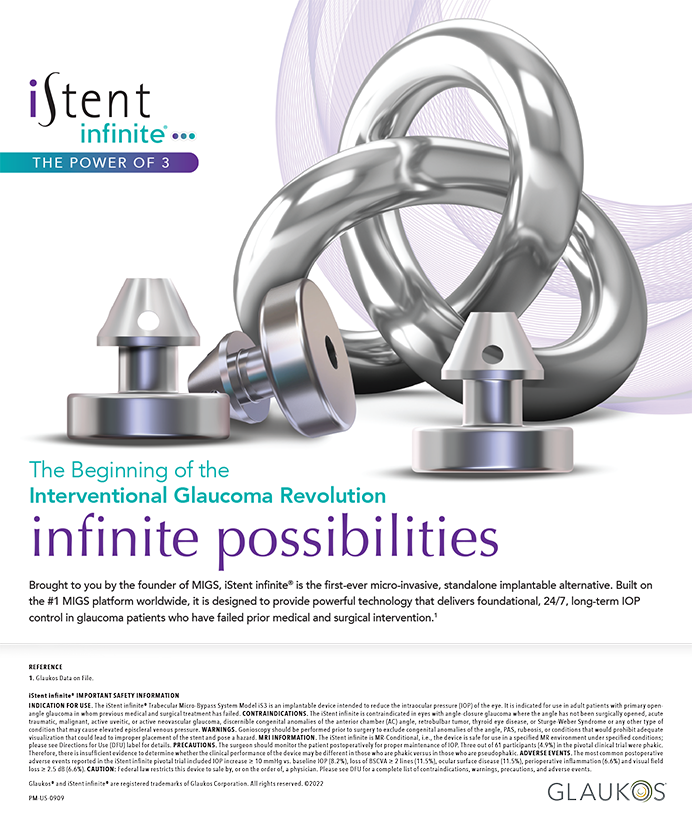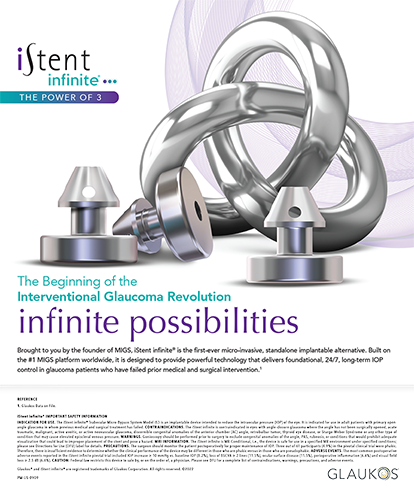With each passing week, the benefits of presbyopia- and astigmatism-correcting IOLs become better known and documented. Although choosing a lens depends on the individual patient's needs, a large proportion of ophthalmologists agree that these premium IOLs in general offer better visual function, greater spectacle independence, and lower levels of astigmatism (using toric IOLs) than standard monofocal lenses. Despite their success rates, the adoption rate of premium lenses remains relatively low at roughly 14.8% of all IOL implants (Figure), according to a September 2011 survey of US IOL surgeons by Market Scope, LLC (St. Louis, MO).
Why the apparent drag in conversion rates? According to several leading ophthalmologists and industry watchers, the cause is multifactorial, and it may take a new technology— the femtosecond laser for cataract surgery—to fully realize the benefits of a premium lens. Those interviewed for this story identified several potential causes of the slow adoption rate, including the economy, physician-patient communication, and technological limitations. This article reviews those ideas and offers advice from cataract surgeons with successful premium IOL practices on how to increase the number of these lenses that you implant.
ECONOMIC EFFECT
Whenever a patient, or any consumer for that matter, is asked to pay an extra charge for a service or product in which the standard of care is covered by the US government, he or she is going to hesitate. The economic recession of the past 5 years has exacerbated that reaction. As a result, many cataract surgeons, about 25% according to Market Scope, do not even offer presbyopia- or astigmatism-correcting IOLs. Considering the economic forces that have affected many of the aging baby boomers, ophthalmic practices that do offer premium lenses may be holding back on promoting them.
“It has to do with consumerism,” Samuel Masket, MD, told Cataract & Refractive Surgery Today at the American Academy of Ophthalmology's (AAO) annual meeting in Orlando, Florida. Dr. Masket is a clinical professor at the David Geffen School of Medicine, UCLA. “Once the patient has to reach into his or her pocket and pay for a product, the relationship between the physician or surgeon and patient changes to one where the patient now is a consumer. This places demands on the practitioner to explain the technology and to properly implement it.”
Viewing a patient as a consumer has been a major stumbling block for many surgeons, Dr. Masket said, but the issue is not as simple as dollars and cents. Although up to $4,000 per eye for a premium lens is a hefty price tag for many, informing the patient of the value of the investment is key, many ophthalmologists advised.
“I think one of the reasons that premium IOLs have been slow to be adopted is that patients may not necessarily understand the value of the lenses and some physicians for that matter as well,” Bret Fisher, MD, medical director of The Eye Center of North Florida in Panama City, told CRSToday at the AAO meeting. “The lenses really are, in my mind, an incredible value, an incredible technology, and I think, if more patients were educated about the value that they bring to their lives, they would be more interested and more willing to have a premium IOL.”
Shareef Mahdavi, president of SM2 Strategic in Pleasanton, California, acknowledged that the economy has had some effect on the slow adoption rate, but he believes it is more of an excuse for practices than an actual cause.
“We know this because there are practices that routinely convert [to premium IOLs] 30% to 50% of interested and eligible candidates,” Mr. Mahdavi wrote in an e-mail to CRSToday. “Our research shows that 80% of cataract patients are interested in a glasses-free solution that helps them see their best, and fully one in four says that money is no object.”
Of the 279 patients who completed an online survey for SM2 Strategic, a majority said they would like unaided vision for all distances, and nearly half (47%) reported a willingness to pay at least $1,000 more per eye for this outcome.1
PHYSICIAN-PATIENT COMMUNICATION
If convincing patients that premium IOLs are more costeffective in the long run than conventional IOLs is necessary, then knowing the best method to communicate options to your patients is crucial.
“I think that some surgeons may be uncomfortable talking to patients about certain aspects of the lenses—you know, the plusses, the minuses, the limitations of the technologies, and the benefits,” said Dr. Fisher. “It is important to discuss these honestly and make sure the patients understand. And, even things like talking about price I think is hard for some physicians and may present a barrier, but I think that is something we can all kind of get through with a little bit of effort and desire.”
It may not just be a lack of interest in communicating the benefits of premium IOLs to patients. It could also be a lack of skill.
Mitchell A. Jackson, MD, is the founder and director of Jacksoneye in Lake Villa, Illinois. He said a strategy that he implements when selling premium IOLs is to minimize the options and make it simple for patients to understand. Depending on their evaluation, Dr. Jackson provides the following three options to his patients.
First is the “standard option” or the “government option,” because the government or insurance companies pay for it. It includes standard phacoemulsification and no upgrades of any type (LASIK, limbal relaxing incisions, etc.). With this option, Dr. Jackson guarantees his patients that they will need to wear glasses full time after surgery for any level of vision. Second is the “driving option” or the “toric IOL tier.” In this option, Dr. Jackson talks to his patients about the goals of providing driving vision and seeing at distance. The patient signs an Advanced Beneficiary Notice statement guaranteeing a refractive outcome to be able to drive at the legal level without spectacles. A middle-tier pricing upgrade is charged. Third is the “forever young option,” wording that Dr. Jackson prefers to “presbyopia-correcting,” because most patients do not understand what the term presbyopia means. In this option, there is no guarantee, but a reduced dependency on spectacles at all levels of vision is the goal. Dr. Jackson charges a top-tier upgrade.
Daniel S. Durrie, MD, the director of Durrie Vision in Overland Park, Kansas, brings a different perspective to the topic. Because his business operates as a refractive surgery practice, 98.7% of his patients receive premium IOLs. Based on his experience, the problem is not resistance from the patients to the lenses or even their cost; it is a lack of confidence on the part of the physician.
“The real lack of penetration comes from the fact that a lot of our doctors don't feel like they can deliver the promise that they are going to give to the patient,” Dr. Durrie said. “If they say, ‘We are going to do a presbyopiacorrecting IOL, and we are going to give you near and distance vision without glasses for a lifetime,' a lot of doctors aren't willing to say that, because they are afraid they won't deliver—because of the accuracy of their IOL calculations, the equipment that they are using, or even just their overall confidence.”
Dr. Durrie added, “I think the growth in the premium channel of IOLs is being limited by the doctors' not feeling like they have the tools or the IOLs or the delivery system to be able to give what the patient wants.”
LIMITATIONS OF THE TECHNOLOGY
Not having the confidence to assure patients of the desired results is, in a way, a reflection of the limits of the improving yet imperfect technology. If surgeons do not fully believe in a technology or if they have experienced inconsistent results with it, they will hesitate to make promises to patients. According to the doctors consulted for this article, the best solution is to be as upfront as possible with a patient about potential side effects.
“I think one of our problems is we don't have the perfect technology,” said Karl Stonecipher, MD, director of refractive and refractive cataract surgery at Southeastern Eye Center in Greensboro, North Carolina. “Are we working towards that? Absolutely. Are there a lot of things in the pipeline? Yes. But, the current technology does have limitations. These limitations can cause postoperative side effects, so what we are doing is trying to show patients what those side effects may be so they have a better understanding on the front side. Now, does that help them postoperatively? Absolutely, because they know what to expect and are not surprised with the positive and negative aspects of the technology. It also helps me pick the perfect IOL for that particular patient.”
Of the roughly 14.8% of cataract patients who receive premium lens implants, about 7.3% were toric lenses and 7.5% were multifocal and accommodating lenses, according to Market Scope's September 2011 survey of 571 US IOL surgeons. When evaluating the future of toric lenses, some believe growth lies in the release of better imaging tools.
“The [toric IOL] technology is really quite good, but I think we will have better ways of measuring the amount of cylinder and how to properly position the lens with some wonderful imaging tools that are on the market and coming onto the market here in the United States today,” Dr. Masket said.
With respect to presbyopia-correcting lenses, Dr. Masket said he is hopeful that the future will bring accommodating lenses that really provide a significant degree of accommodation while at the same time providing some adjustability of the outcome so that the emmetropic target can be reached.
“Most patients really do want to reduce their dependence on spectacles, and not offering these [premium IOL] tools I think is really in some sense disserving the patient,” Dr. Masket said. “So, if one takes the time to talk to the patients about reduced spectacle dependence, my sense is that the patients would really want this and would be willing to pay out of pocket for this improvement in their lifestyle.”
Samuel Masket, MD, is in private practice in Los Angeles. He is a consultant to Alcon Laboratories, Inc. Dr. Masket may be reached at (310) 229-1220; avcmasket@aol.com.
Bret L. Fisher, MD, is a consultant to Alcon Laboratories, Inc. Dr. Fisher may be reached at (850) 784- 3937; bfisher@eyecarenow.com.
Shareef Mahdavi advises numerous ophthalmic companies, including Alcon Laboratories, Inc., Bausch + Lomb, CareCredit, and WaveTec Vision. Mr. Mahdavi may be reached at (925) 425-9900; shareef@sm2strategic.com.
Mitchell A. Jackson, MD, is on the speakers' bureaus of Abbott Medical Optics Inc., Alcon Laboratories, Inc., and Bausch + Lomb. Dr. Jackson may be reached at (847) 356-0700; mjlaserdoc@msn.com.
Daniel S. Durrie, MD, is a consultant to Alcon Laboratories, Inc. Dr. Durrie may be reached at (913) 491-3330; ddurrie@durrievision.com.
Karl G. Stonecipher, MD, is a consultant to Alcon Laboratories, Inc., Allergan Inc., and Bausch + Lomb. Dr. Stonecipher may be reached at (336) 288-8523; stonenc@aol.com.
Market Scope surveys ophthalmologists about cataract, refractive, retina, and glaucoma business and medical issues. Surveys are confidential, and participants receive free access to survey results. To participate and get more information, please visit www.practice.scope.com. Market Scope may be reached at (314) 835-0600 or info@market-scope.com.


